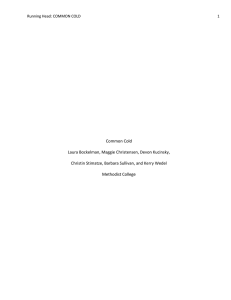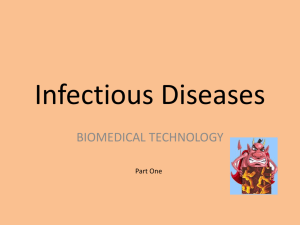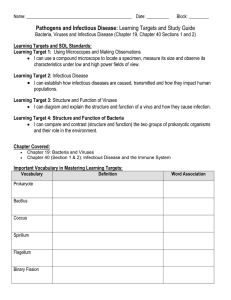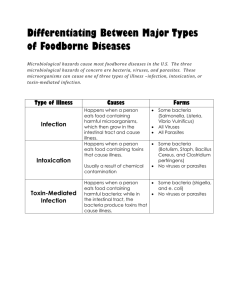GLOSSARY
advertisement
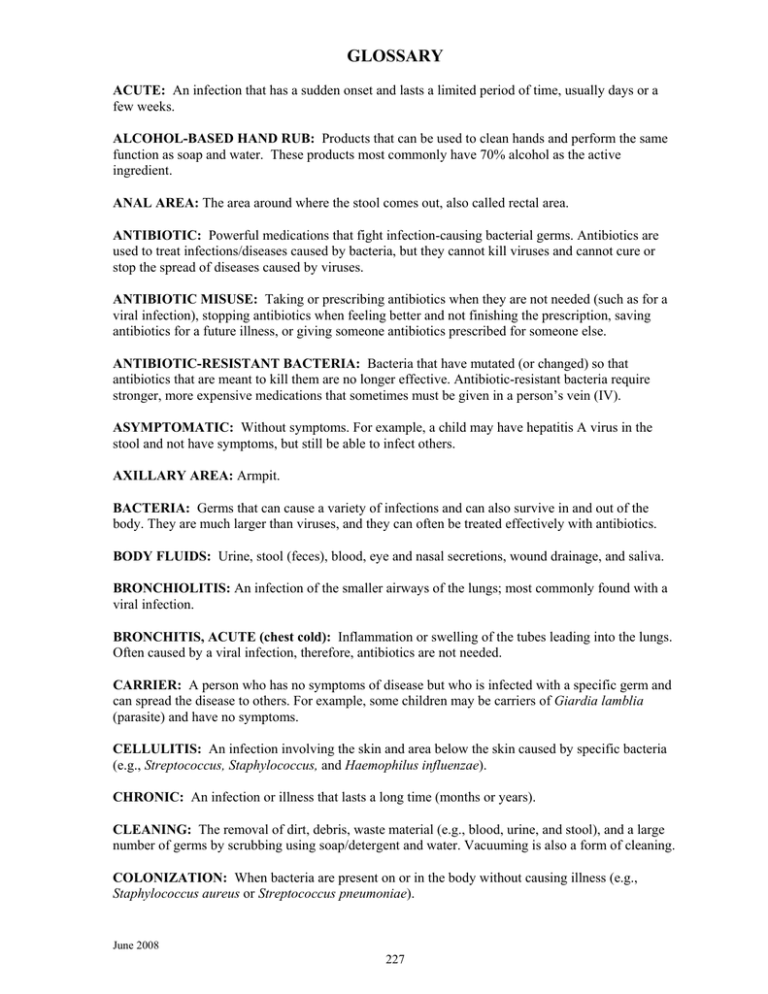
GLOSSARY ACUTE: An infection that has a sudden onset and lasts a limited period of time, usually days or a few weeks. ALCOHOL-BASED HAND RUB: Products that can be used to clean hands and perform the same function as soap and water. These products most commonly have 70% alcohol as the active ingredient. ANAL AREA: The area around where the stool comes out, also called rectal area. ANTIBIOTIC: Powerful medications that fight infection-causing bacterial germs. Antibiotics are used to treat infections/diseases caused by bacteria, but they cannot kill viruses and cannot cure or stop the spread of diseases caused by viruses. ANTIBIOTIC MISUSE: Taking or prescribing antibiotics when they are not needed (such as for a viral infection), stopping antibiotics when feeling better and not finishing the prescription, saving antibiotics for a future illness, or giving someone antibiotics prescribed for someone else. ANTIBIOTIC-RESISTANT BACTERIA: Bacteria that have mutated (or changed) so that antibiotics that are meant to kill them are no longer effective. Antibiotic-resistant bacteria require stronger, more expensive medications that sometimes must be given in a person’s vein (IV). ASYMPTOMATIC: Without symptoms. For example, a child may have hepatitis A virus in the stool and not have symptoms, but still be able to infect others. AXILLARY AREA: Armpit. BACTERIA: Germs that can cause a variety of infections and can also survive in and out of the body. They are much larger than viruses, and they can often be treated effectively with antibiotics. BODY FLUIDS: Urine, stool (feces), blood, eye and nasal secretions, wound drainage, and saliva. BRONCHIOLITIS: An infection of the smaller airways of the lungs; most commonly found with a viral infection. BRONCHITIS, ACUTE (chest cold): Inflammation or swelling of the tubes leading into the lungs. Often caused by a viral infection, therefore, antibiotics are not needed. CARRIER: A person who has no symptoms of disease but who is infected with a specific germ and can spread the disease to others. For example, some children may be carriers of Giardia lamblia (parasite) and have no symptoms. CELLULITIS: An infection involving the skin and area below the skin caused by specific bacteria (e.g., Streptococcus, Staphylococcus, and Haemophilus influenzae). CHRONIC: An infection or illness that lasts a long time (months or years). CLEANING: The removal of dirt, debris, waste material (e.g., blood, urine, and stool), and a large number of germs by scrubbing using soap/detergent and water. Vacuuming is also a form of cleaning. COLONIZATION: When bacteria are present on or in the body without causing illness (e.g., Staphylococcus aureus or Streptococcus pneumoniae). June 2008 227 GLOSSARY COMMUNICABLE DISEASE: Illness caused by germs (e.g., bacteria, viruses, fungi, parasites) that can be spread from person to person or by touching objects contaminated with body fluids. Illness can be spread from infected pets. Many communicable diseases are reportable to the local or state health department. CONJUNCTIVITIS (PINKEYE): Redness and swelling of the delicate tissue which lines the eyelids and covers the eyeball (conjunctiva). CONTAGIOUS PERIOD: The period of time when an infected person is capable of spreading infection to another person. CONTAMINATION: The presence of infectious germs in or on the body, on environmental surfaces, on articles of clothing, or in food or water. CROUP: Spasms of the airway that cause difficult breathing and a cough sounding like a seal's bark. Viruses most often cause croup; therefore, antibiotics are not needed. DIARRHEA: Increased number of stools compared with a person's normal pattern, along with decreased stool form and/or watery, bloody, or mucus-containing stools. DISINFECTION: A physical or chemical process that eliminates virtually all disease-causing germs on environmental surfaces, except bacterial spores. ENCEPHALITIS: Inflammation (swelling) of the brain which can be caused by a number of agents such as viruses, bacteria, or parasites. EPIDEMIOLOGY: The scientific study of the occurrence and distribution of diseases in populations. EXCLUSION (DUE TO ILLNESS): Denying admission of an ill child or staff member to a childcare, preschool, school, or worksite. FEBRILE: Having a fever. FECES: Another name for stool or bowel movements. Waste material that is formed and not used by the body. FEVER: An elevation of body temperature. This could be due to overheating, reactions to medications, or a response to infection. FUNGI: Plant-like organisms, such as yeasts, molds, mildew, and mushrooms, which get their nutrition from other living organisms or from dead organic matter. GERMS: A common term used to describe bacteria, viruses, parasites, and fungi. HEPATITIS: Inflammation of the liver, which may be caused by a virus. HYGIENE: Protective measures taken by individuals to promote health and limit the spread of infectious diseases, for example, handwashing and covering your cough. IMMUNE GLOBULIN (IG): An antibody preparation made from human plasma, providing temporary protection against diseases. For example, health officials may offer immune globulin injections to children and staff in a childcare setting when cases of hepatitis A occur. June 2008 228 GLOSSARY IMMUNITY: The body's ability to fight a particular infection. For example, a child acquires immunity to diseases such as measles, mumps, rubella, and pertussis after natural infection or by vaccination. Newborns initially have the same immune status as their mothers. This immunity usually disappears within the first 6 months of life. IMMUNIZATIONS (VACCINATIONS): Vaccines that are given to children and adults to help them develop protection (antibodies) against specific infections. Vaccines may contain an inactivated or killed agent or a weakened live organism. IMMUNOCOMPROMISED: The state of having a weakened body defense (decreased immune responses) against diseases caused by bacteria, parasites, fungi, or viruses. INCUBATION PERIOD: The time between exposure to an infectious agent and the beginning of symptoms. INFECTION: A condition caused by the multiplication of an infectious agent in the body. INFECTIOUS: Capable of causing an infection. INFESTATION: Common term referring to the presence of parasites, such as lice or scabies. INFLUENZA: An acute viral disease of the respiratory tract caused by the influenza virus. Influenza should not be confused with a bacterial infection called Haemophilus influenzae or with "stomach flu" (usually vomiting and diarrhea). JAUNDICE: Yellowing of the whites of the eyes or skin. LOW-GRADE FEVER: A fever that is slightly higher than normal. MENINGITIS: A swelling or inflammation of the tissue covering the brain and spinal cord. Meningitis is usually caused by a bacterial or viral infection. MENINGOCOCCUS: Neisseria meningitidis bacteria which can cause meningitis, pneumonia, or blood infections. ORAL: Having to do with the mouth. OVER THE COUNTER (OTC): Any medication that can be purchased without a prescription. OTITIS MEDIA: Inflammation or infection of the middle part of the ear. Ear infections may be caused by Streptococcus pneumoniae or Haemophilus influenzae. They are not contagious. PARASITE: An organism that can only live on or in another living organism. PAROTID GLAND: A salivary gland situated at the base of each ear. PEDICULOSIS: Another word for lice infestation. PNEUMONIA: An acute or chronic disease marked by infection of the lung; may be caused by viruses, bacteria, or other germs and sometimes by physical or chemical irritants. June 2008 229 GLOSSARY PROPHYLAXIS (PREVENTIVE TREATMENT): Measures taken before, during, or shortly after exposure to an infectious disease to try to prevent the disease. This may include medications or vaccinations. PUSTULES: Pus-filled bumps on the skin. RECTAL: Having to do with the rectum, the last 6 to 8 inches of the large intestine that serves to store solid waste until it leaves the body through the anus. RESPIRATORY SYSTEM: The nose, ears, sinuses, throat, and lungs. SANITIZING: The chemical process of reducing the number of disease-causing germs to a safe level on cleaned food contact surfaces and mouthed toys, objects, and surfaces. SECRETIONS: Wet material produced by cells or glands that has a specific purpose in the body, such as saliva. SOILED: Contaminated with dirt; stool; urine; vomit; blood; saliva; or drainage from the eye, nose, or wound. SORES: Open skin lesions usually caused by an infection. STANDARD PRECAUTIONS: Are used in many settings where there is a possibility of exposure to blood and body fluids (e.g., urine, stool, secretions from the nose and mouth, drainage from sores or eyes). One aspect of standard precautions is the use of barriers. The purpose of using barriers is to reduce the spread of germs to staff and children from known/unknown sources of infections and prevent a person with open cuts, sores, or cracked skin (non-intact skin) and their eyes, nose, or mouth (mucous membranes) from having contact with another person’s blood or body fluids. Examples of barriers are gloves, safety needle/sharp devices and proper disposal of used needles and sharps, and CPR mask or shield. STOOL: Another name for feces or bowel movements. Waste material that is formed and not used by the body. TRANSMISSION: The spread of an infectious organism or germ from an infected person or animal or contaminated environmental surface to a person. Swimming in or drinking water from a contaminated water source can also spread organisms. VACCINATIONS (IMMUNIZATIONS): Vaccines that are given to children and adults to help them develop protection (antibodies) against specific infections. Vaccines may contain an inactivated or killed agent or a weakened live organism. VARICELLA-ZOSTER: The herpesvirus that causes chickenpox (varicella) and shingles (zoster). VIRUS: A type of germ that lives within cells that is smaller than bacteria. Viruses can grow or reproduce only in living cells. Antibiotics will not fight against viruses - viral infections clear up on their own and antibiotics will not help. VOMITING: To throw up. The act of ejecting the stomach contents through the mouth. June 2008 230
